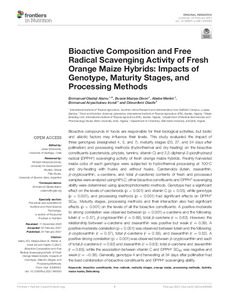| dc.contributor.author | Alamu, E.O. |
| dc.contributor.author | Maziya-Dixon, B. |
| dc.contributor.author | Menkir, A. |
| dc.contributor.author | Irondi, E.A. |
| dc.contributor.author | Olaofe, O. |
| dc.date.accessioned | 2022-09-16T08:30:47Z |
| dc.date.available | 2022-09-16T08:30:47Z |
| dc.date.issued | 2021-02-24 |
| dc.identifier.citation | Alamu, E.O., Maziya-Dixon, B., Menkir, A., Irondi, E.A. & Olaofe, O. (2021). Bioactive composition and free radical scavenging activity of fresh orange maize hybrids: impacts of genotype, maturity stages, and processing methods. Frontiers in Nutrition, 8:640563, 1-10. |
| dc.identifier.issn | 2296-861X |
| dc.identifier.uri | https://hdl.handle.net/20.500.12478/7758 |
| dc.description.abstract | Bioactive compounds in foods are responsible for their biological activities, but biotic and abiotic factors may influence their levels. This study evaluated the impact of three genotypes (designated 4, 5, and 7), maturity stages (20, 27, and 34 days after pollination) and processing methods (hydrothermal and dry-heating) on the bioactive constituents (carotenoids, phytate, tannins, vitamin C) and 2,2-diphenyl-2-picrylhydrazyl radical (DPPH*) scavenging activity of fresh orange maize hybrids. Freshly harvested maize cobs of each genotype were subjected to hydrothermal processing at 100°C and dry-heating with husks and without husks. Carotenoids (lutein, zeaxanthin, β-cryptoxanthin, α-carotene, and total β-carotene) contents of fresh and processed samples were analyzed using HPLC; other bioactive constituents and DPPH* scavenging ability were determined using spectrophotometric methods. Genotype had a significant effect on the levels of carotenoids (p < 0.001) and vitamin C (p < 0.05), while genotype (p < 0.001), and processing methods (p < 0.001) had significant effects on DPPH* SC50. Maturity stages, processing methods and their interaction also had significant effects (p < 0.001) on the levels of all the bioactive constituents. A positive moderate to strong correlation was observed between (p < 0.001) α-carotene and the following: lutein (r = 0.57), β-cryptoxanthin (r = 0.69), total β-carotene (r = 0.62). However, the relationship between α-carotene and zeaxanthin was positive but weak (r = 0.39). A positive moderate correlation (p < 0.001) was observed between lutein and the following: β-cryptoxanthin (r = 0.57), total β-carotene (r = 0.58), and zeaxanthin (r = 0.52). A positive strong correlation (p < 0.001) was observed between β-cryptoxanthin and each of total β-carotene (r = 0.92) and zeaxanthin (r = 0.63); total β-carotene and zeaxanthin (r = 0.65); while the association between vitamin C and DPPH* SC50 was negative and weak (r = −0.38). Generally, genotype 4 and harvesting at 34 days after pollination had the best combination of bioactive constituents and DPPH* scavenging ability. |
| dc.description.sponsorship | International Institute of Tropical Agriculture |
| dc.description.sponsorship | Bill & Melinda Gates Foundation |
| dc.format.extent | 1-10 |
| dc.language.iso | en |
| dc.subject | Bioactive Properties |
| dc.subject | Maize |
| dc.subject | Maturity |
| dc.subject | Processing |
| dc.subject | Hybrids |
| dc.subject | Husks |
| dc.subject | Carotenoids |
| dc.subject | Genotypes |
| dc.title | Bioactive composition and free radical scavenging activity of fresh orange maize hybrids: impacts of genotype, maturity stages, and processing methods |
| dc.type | Journal Article |
| cg.contributor.crp | Agriculture for Nutrition and Health |
| cg.contributor.crp | Maize |
| cg.contributor.crp | Roots, Tubers and Bananas |
| cg.contributor.affiliation | International Institute of Tropical Agriculture |
| cg.contributor.affiliation | Kwara State University |
| cg.contributor.affiliation | Ekiti State University |
| cg.coverage.region | Africa |
| cg.coverage.region | West Africa |
| cg.coverage.country | Nigeria |
| cg.coverage.hub | Southern Africa Hub |
| cg.coverage.hub | Headquarters and Western Africa Hub |
| cg.researchtheme | Biotech and Plant Breeding |
| cg.researchtheme | Nutrition and Human Health |
| cg.identifier.bibtexciteid | ALAMU:2021b |
| cg.isijournal | ISI Journal |
| cg.authorship.types | CGIAR and developing country institute |
| cg.iitasubject | Agronomy |
| cg.iitasubject | Maize |
| cg.iitasubject | Nutrition |
| cg.iitasubject | Plant Breeding |
| cg.iitasubject | Plant Production |
| cg.iitasubject | Value Chains |
| cg.journal | Frontiers in Nutrition |
| cg.notes | Published online: 24 Feb 2021 |
| cg.accessibilitystatus | Open Access |
| cg.reviewstatus | Peer Review |
| cg.usagerightslicense | Creative Commons Attribution 4.0 (CC BY 0.0) |
| cg.targetaudience | Scientists |
| cg.identifier.doi | https://dx.doi.org/10.3389/fnut.2021.640563 |
| cg.iitaauthor.identifier | Alamu Emmanuel Oladeji (PhD, FIFST, MNIFST): 0000-0001-6263-1359 |
| cg.iitaauthor.identifier | Busie Maziya-Dixon: 0000-0003-2014-2201 |
| cg.iitaauthor.identifier | Abebe Menkir: 0000-0002-5907-9177 |
| cg.futureupdate.required | No |
| cg.identifier.volume | 8 |

